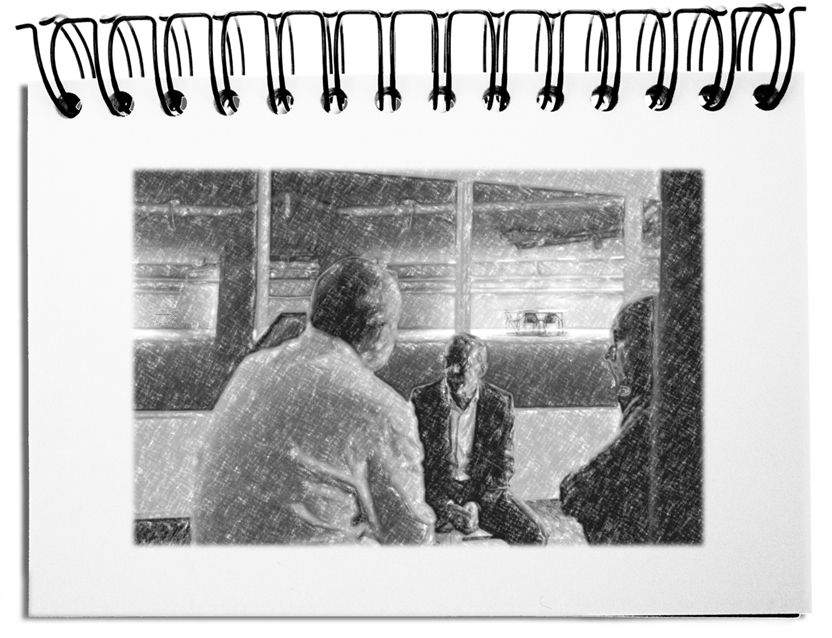In the beginning, was the difference! To before – whatever that was. Since then, becoming been happening. At every moment, reality gets further fractalized. There is no end in sight. We are observers looking out of our box, absorbing the world’s stimuli, and processing them in our minds. We associate the symbol o with a tetragon or a rectangle, or a square. For some, it is simply an incomprehensible something. Some people recognize this symbol © as an automotive brand. Interested people wonder. The disinterested ignore. The only real thing is the sign © at this point. What someone explains becomes the meaning – until somebody else provides another explanation. Who’s right? Both! The meaning is always in the eye of the beholder.
Since our knowledge is constantly evolving, every realization already contains its replacement by a new (un)truth, which is also more or less quickly superseded. We climb the mountain of knowledge with the assumption that we are heading for a peak. Along the way, (un)truths are found in various states: Fact, opinion, faith, fallacy, or conspiracy.
- The (un)truth as a fact
The expected normal state of an occurring circumstance is a provable or generally accepted fact. Gottlob Frege distinguished facts of the real world and thoughts. “Reality” can be grasped most precisely with the available measuring tools. Thoughts are accessible only indirectly through inquiry and filtered expression
At the end of the 16th-century, scientists explained electrical attraction as a consequence of the fluidum surrounding a body as a cloud of vapor attracting other substances. Today we see the reason in positive and negative charges of the elementary particles. Until science provides an accepted explanation, the fact lacks the blessing. An example of a rejection of the science community is the morphic field of the biologist Rupert Sheldrake – although no other proofs are given. Accordingly, an article on morphic fields in the German Wikipedia has not yet made it into the English one. Mental issues become plausible only by their coherence. Varying explanations turn them into opinions. Except: We follow Kellyanne Conway and consider the notion of alternative facts.
Science and measuring tools are the basis for contemporary truths, which abruptly become falsehoods through new measurements. The realm beyond measurability is called metaphysics. - The (Un)Truth as Opinion
The opinion is a personal believing in a case that can be inferred by explanation, even if there is no tangible evidence. A hypothesis remains an opinion until it is “proven”. The morphic fields above are a good example. Another one is the Higgs boson that was formulated in 1964 and not proven until 2012 in the LHC.
In contrast to the fact, whose existence is based on quantitative and numerical evaluations, opinions are expressed, explained, and eventually substantiated. Wittgenstein had already focused attention on the interplay (TLP 1.1 “The world is the totality of facts, not of things.“). However, it is left to the audience to adopt an opinion that arises – i.e., to think it is correct and to believe it (not in the religious sense – see the next point).
Opinions are more contagious and easier to repeat, pass on, and apply in different contexts and have longevity. Opinions make the same powerful impact on the opinioning ones as facts. However, it is more difficult to get rid of deep convictions. - The (Un)Truth as Faith
Religion strongly overlaps with opinion, as both manifest as doctrine in the minds of “fans”. This overlapping explains why opinions are readily defamed as esotericism. The present description makes a distinction between an opinion and a religious belief – as secular and spiritual.
The awe of an order that cannot be explained or proven, but is built on traditional dogma, creates in believers a truth that is incomprehensible to “non-believers”. According to Gallup, in the U.S. in 2019, 40% of the population, the so-called creationists, believed that God created man in his present form. 33% that man evolved with God’s guidance (i.e., Intelligent Design). Only 22% believed in evolution, i.e., that God had no part in the development.
Article four of the German constitution states, “(1) The freedom of faith, conscience and the freedom of religious and ideological confession are inviolable. (2) The undisturbed practice of religion is guaranteed.” This makes faith a personal attitude that is not debatable. (Un)truths arise as a consequence for each person. - The (un)truth as a fallacy
As soon as a fact or an opinion turns out to be false, we speak of a fallacy. Whether an opinion or a religious belief is a deception must be made by each person for oneself.
Karl Popper formed the concept of falsifiability. He showed that no theory could be verified one hundred percent. The only certainty we get is finding proof of a fact’s wrongness (to falsify). The appearance of ONE black swan disproves the statement that all swans are white and the original “truth” is false. Let us think of the statement The earth is a disk. Even the Greeks recognized the spherical shape. By the 19th century, the fallacy had spread that medieval society considered the earth being flat, which never happened. At the latest with the Apollo missions, the last ones should be convinced of the “sphere”, except a few conspiracy theorists.
Especially realists and materialists are challenged by fallacies as soon as different disciplines and contradictory study results question their worldview. This uncertainty becomes visible in the compulsive urge to defend one’s findings and defame new approaches even without a better explanation. Although we know, according to Popper, that the fallacy is the more factual counterpart of the fact. - The (un)truth as a conspiracy theory
A particular genre is fake news or conspiracy theories, which are deliberately put into the world to manipulate people by pretending facts. Fatally, these terms have become a rhetorical killer phrase. If someone doesn’t like a statement or point of view, it is maligned as fake news and conspiracy theory.
The previous president of the United States showed how this is done, and politicians around the world have adopted this approach. At the same time, fake news is penetratingly hammered into the heads of inattentive listeners until they can only conclude that these facts must be true. However, in the beginning, it is mainly deliberate lying, which might become a conspiracy over time. A conspiracy needs conspirators who secretly join forces to bring about conditions they desire by putting corresponding theories into the world. For this purpose, the agitators turn the tables and accuse the opponent of wanting to seduce the population with magic and incitement. They develop untruths and cement them through so-called evidence and other dubious claims into the mind of the victims. Thereby a thought model difficult to grasp is created, characterized by fatal stability, and that can only be refuted with effort.
The manipulators tend to strike back prophylactically by denigrating the opposing parties’ facts, opinions, and beliefs as conspiracy theories. This creates fear of contact and makes discourse impossible. For this reason, it is crucial to make these untruths visible at an early stage and to set up effective countermeasures – taking the concerns of the target groups seriously; answering easy-to-understand arguments with simple counterarguments; provide more appealing platforms than the agitators.
Bottom line: Today’s (un)truths spread rapidly with one click of a mouse throughout the world. As long as we do not learn to deal with them, the propagandists will receive a large influx. It is vital to be aware of a fact’s temporary validity and be open to new things. Opinions are the precursor to facts because they build a thought model that only needs to be proven. If it is a religious belief, then we must tolerate it because everyone has a right of their faith – which should a priori rule out religious wars. As soon as we falsify a fact, a hundred percent truth emerges – that it is simply not as conceived. The organized seduction of the public is linked to a purpose – maintaining or acquiring power. Conspiracies are hard to unravel because their adherents develop a quasi-religious conviction. In the end, the world is constantly changing and creating (un)truths with and without intent.


